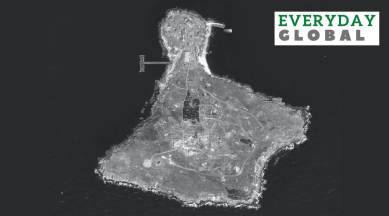Explained: The importance of Snake Island, speck of land in the Black Sea, where Ukraine has bombed Russia
Ukraine has said it has caused "significant losses" to the Russian military in airstrikes on Zmiinyi Island, also known as Snake Island, in the Black Sea. Where is this island, and why is it strategic for Ukraine?

Ukraine has said it has caused “significant losses” to the Russian military in airstrikes on Zmiinyi Island, also known as Snake Island, in the Black Sea. The hit on the island is believed to be the second major military success using missiles given to Ukraine by the West. The Ukrainians had last week claimed their first successful use of Harpoon anti-ship missiles, British Military Intelligence said on June 21, Reuters reported.
Snake Island strike
The Guardian quoted from a video address by the Ukraine military’s southern operational command: “The island of Zmiinyi was dealt a concentrated blow with the use of various forces and methods of destruction… The military operation continues and requires information silence until it is over.”
The Russians on their part posted on Telegram that at 5 am on June 20, the “Kyiv regime undertook another mad attempt to take possession of Snake Island”. Airstrikes were launched by 15 Ukrainian attack and reconnaissance drones, and missile launchers and howitzers were fired at the island, The Guardian report quoted the Russian defence ministry as saying.
It said 13 drones were reported shot down, and that Russia had called it “another fake ‘victory’ of the Ukrainian military”.
“We already know that the Pantsir anti-aircraft missile system was very badly damaged, possibly completely destroyed, we know that the radar station was very badly damaged, and there are other enemy losses that we’re verifying to take into account,” the Ukrainian news agency Ukrinform quoted Natalia Humeniuk, head of the joint coordination centre of Ukraine’s South Defence Forces, as saying.
“The operation is underway and I think we will deliver a follow-up really soon,” Humeniuk said, according to Ukrinform.
Strategic island
Zmiinyi Island, also known as Snake or Serpent Island, is a small piece of rock less than 700 metres from end to end, that has been described as being “X-shaped”. It is located 35 km from the coast in the Black Sea, to the east of the mouth of the Danube and roughly southwest of the port city of Odessa.
The island, which has been known since ancient times and is marked on the map by the tiny village of Bile that is located on it, belongs to Ukraine. On February 24, the day Russia launched its invasion, two warships from the Russian Black Sea Fleet, Vasily Bykov and Moskva, attacked Snake Island, followed by Russian troops landing on it.
Ukraine has claimed to have launched several attacks on the Russian occupiers of Snake Island even before the latest ongoing operation. Last week, Ukraine said it had sunk a Russian naval tug called Spasatel Vasily Bekh, which was delivering personnel and military supplies to the island. Earlier in April, it had sunk the Moskva, the 600-foot flagship of the Black Sea Fleet, which had attacked the island on day 1 of the war.
The Black Sea
The famed water body bound by Ukraine to the north and northwest, Russia and Georgia to the east, Turkey to the south, and Bulgaria and Romania to the west, which links to the Sea of Marmara through the Bosphorus and then to the Aegean through the Dardanelles, has traditionally been Russia’s warm water gateway to Europe.
Newsletter | Click to get the day’s best explainers in your inbox
For Russia, the Black Sea is both a stepping stone to the Mediterranean as well as a strategic buffer between NATO and itself. Domination of the Black Sea region is a geostrategic imperative for Moscow, both to project Russian power in the Mediterranean and to secure the economic gateway to key markets in southern Europe.
Russia has been making efforts to gain complete control over the Black Sea since the Crimean crisis of 2014. The domination of the Black Sea has been a major Russian objective of the ongoing war, along with the land bridge to connect Russia and Crimea. Cutting Ukrainian access to the Black Sea will reduce it to a landlocked country and deal a crippling blow to its trade logistics.